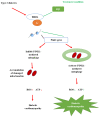Bioactive Components of Salvia and Their Potential Antidiabetic Properties: A Review
- PMID: 34065175
- PMCID: PMC8161164
- DOI: 10.3390/molecules26103042
Bioactive Components of Salvia and Their Potential Antidiabetic Properties: A Review
Abstract
The utilization of therapeutic plants is expanding around the globe, coupled with the tremendous expansion of alternative medicine and growing demand in health treatment. Plants are applied in pharmaceuticals to preserve and expand health-physically, mentally and as well as to treat particular health conditions and afflictions. There are more than 600 families of plants identified so far. Among the plants that are often studied for their health benefit include the genus of Salvia in the mint family, Lamiaceae. This review aims to determine the bioactive components of Salvia and their potential as antidiabetic agents. The search was conducted using three databases (PubMed, EMBASE and Scopus), and all relevant articles that are freely available in the English language were extracted within 10 years (2011-2021). Salvia spp. comprises many biologically active components that can be divided into monoterpenes, diterpenes, triterpenes, and phenolic components, but only a few of these have been studied in-depth for their health benefit claims. The most commonly studied bioactive component was salvianolic acids. Interestingly, S. miltiorrhiza is undoubtedly the most widely studied Salvia species in terms of its effectiveness as an antidiabetic agent. In conclusion, we hope that this review stimulates more studies on bioactive components from medicinal plants, not only on their potential as antidiabetic agents but also for other possible health benefits.
Keywords: Salvia; antidiabetic; bioactive components; human health.
Conflict of interest statement
The authors declare no conflict of interest.
Figures




References
-
- Afrisham R., Aberomand M., Ghaffari M.A., Siahpoosh A., Jamalan M. Inhibitory Effect of Heracleum persicum and Ziziphus jujuba on Activity of Alpha-Amylase. J. Bot. 2015;2015:824683. doi: 10.1155/2015/824683. - DOI
-
- Kooti W., Moradi M., Aliakbari S., Sharafi-Ahvazi N., Asadi-Samani M., Ashtary-Larky D. Therapeutic and pharmacological potential of Foeniculum vulgare Mill: A review. J. Herb. Med. Pharmacol. 2015;4:1–9.
Publication types
MeSH terms
Substances
LinkOut - more resources
Full Text Sources
Medical
Miscellaneous

